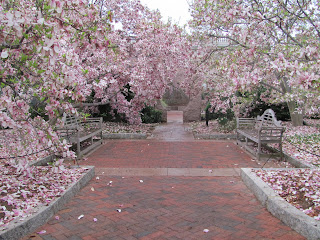So last week, I was teasing a post on Meridian Hill Park almost every day. I kept threatening to post photos on Friday. Sure enough, at around 7:30 Friday morning, blogger was shut down. And by 9am that golden window for me to get a blog post done had closed. So here, a few days later than planned, I'm finally making that post.
This shot above is the north entry of Meridian Hill Park -- at 15th and Euclid Streets. It's a large mall space with the aforementioned
Quercus macrocarpa aligning the walks. It rises slightly uphill as one walks south. To the right, the grade drops severely - two retaining walls, each 20'+ hold the park up. On the left, the park is essentially at grade with 15th Street.
Evidently, this statue of Joan of Arc is the only statue of a
woman on a horse. Which is remarkable, since Washington DC could very well also be called "City of Many Equestrian Statues." Joan looks south and beyond her the park drops in grade considerably. One has a lovely lookout here of the main design gesture of the park -- the cascading water feature.
The park actually sits on the White House meridian line. L'Enfant planned Washington DC using triangles that connect various parts of DC. The White House meridian is a line that connects the Jefferson Memorial, the Washington Monument, the White House and, further north, Meridian Hill Park. The park itself is oriented almost exactly north-south.
Fountains at the head of the cascading pools fill a large upper pool then slowly descend through a series of smaller pools.
As mentioned last week,
Iris pseudacorus aligns the cascade. Junipers are planted along the stepped walkway flanking the water. A curious choice, though I suspect the absence of leaf litter was part of the reasoning.
The park was finished in 1936 though previously the site had been a bucolic campus for Columbian College, which was later renamed George Washington University. At the time, the concrete aggregate forming all the structures was quite new. Personally, I can't stand this look. I would have much preferred all the walls to be stone, but it was pretty trendy at the moment and certainly less expensive than stone.
Paving "stones" were laid out with bluestone aggregate and larger pebble aggregate at the "joints."
The view back north at the cascade. The park is having a series of renovations being performed -- right now the water cascade on the left is not functioning property and the large retaining walls on 16th Street are being repaired. We were there on a Sunday morning and the park was pretty quiet, but it is a great landscape - a lovely beaux arts idyll, hidden in DC.



















































